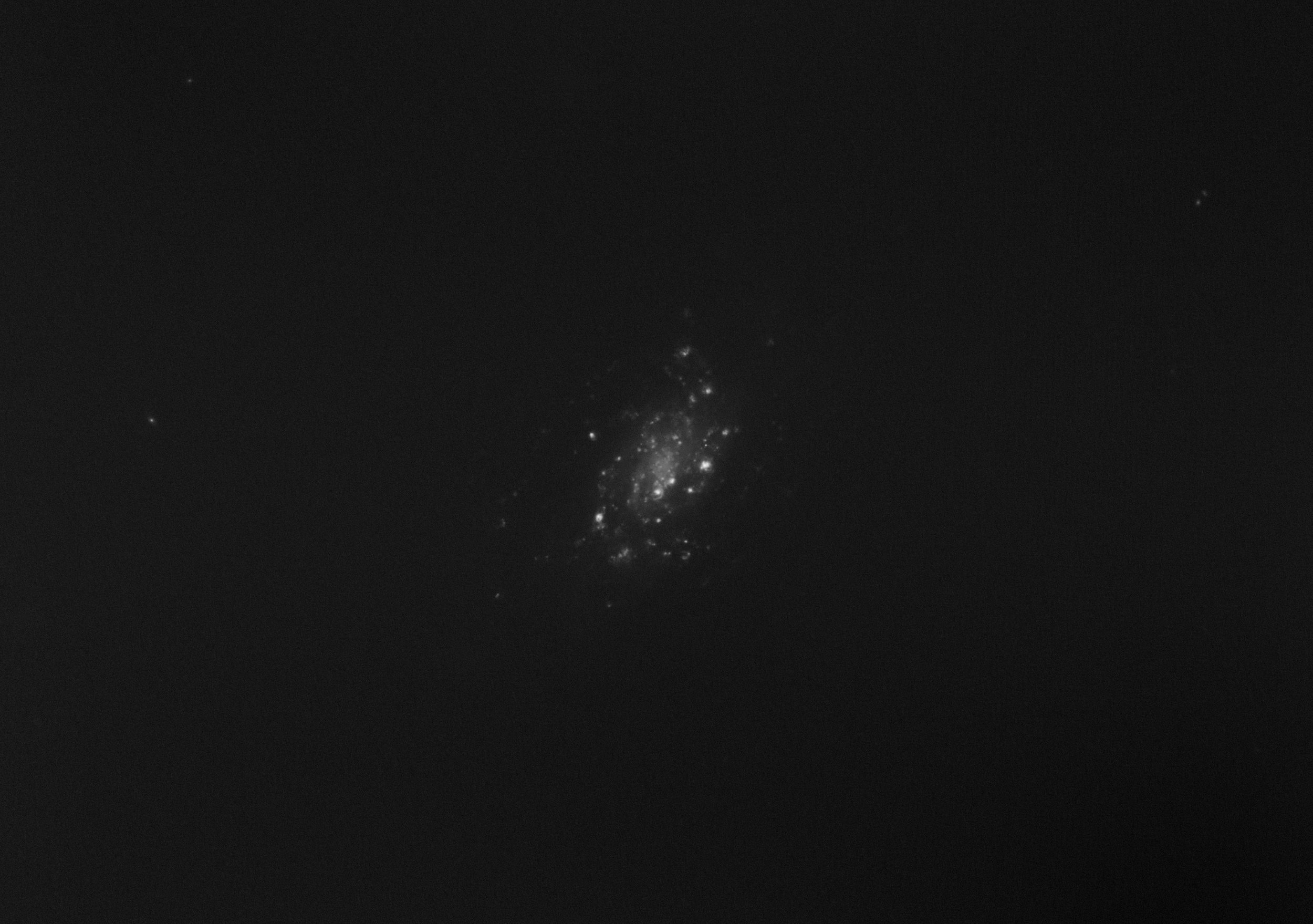Caldwell 7
Caldwell 7 - Click here for full resolution
Caldwell 7 is an intermediate spiral galaxy in the constellation Camelopardalis. It is an outlying member of the M81 Group (one of the nearest groups to the Local Group) and is approximately 8 million light-years distant. It bears a similarity to M33, being about 50,000 light years in diameter and containing numerous star-forming H II regions. The northern spiral arm connects it to the star forming region NGC 2404. NGC 2404 is 940 light-years in diameter, making it one of the largest known H II regions. This H II region represents striking similarity with NGC 604 in M33, both in size and location in galaxy.
source: wikipedia
NGC/IC: NGC2403
Other Names: Caldwell 7
Object: Spiral Galaxy
Constellation: Camelopardalis
R.A.: 07h 36m 51s
Dec: +65º 36.1’
Transit date: 07 February
Transit Alt: 78º N
Sky-plots with a FoV of 50º (left) and 5º (right). Click to enlarge
Conditions
The first images were taken in 2020. Unfortunately the amount of data collected then was not enough. It lasted until March 2022 until the final images were collected during a third session. All Images were taken from the backyard in Groningen, The Netherlands (53.18, 6.54).
Visibility charts showing 22:00h altitude throughout the year (left) and throughout the session on 03 March, 2022 (right).
Weather conditions at each of the sessions were as follows:
Capturing
Telescope
Mount
Camera
Filters
Guiding
Accessoires
Software
Takahashi TOA-130 + FL67 flattener, Sesto Senso 2
10Micron GM1000HPS, Berlebach Planet
ZWO ASI1600MM Pro, cooled to -15 ºC
Astrodon 1.25” LRGB mounted, ZWO EFW 8-position
Unguided
MacMini 2018 (MacOS 10.14.6), Pegasus Ultimate Powerbox v2, Flip Flat
KStars/Ekos 3.5.6, INDI Library 1.9.3, Mountwizzard4 2.1.2, SkySafari 6.8.2, openweathermap.org, PixInsight 1.8.9
Exposure
Geometry
Annotated image showing the deep sky objects, and some of the brighter stars
Processing
All frames were calibrated with Bias (100), Dark (50) and Flat (25) frames and registered using the WeightedBatchPreprocessing script. Image frames were normalized and scaled using the NormalizeScaleGradient script and integrated using NSG parameters. The images were made in sessions two years apart. This led to some rotation artefacts which were cropped out for all the filters.
First the Luminance image was processed. It was a very clean image, with no visible gradient. So processing involved a fairly straightforward convolution process, followed by HistogramTransformation stretching. The core of the galaxy is quite bright compared to the faint light coming from the arms. A more balanced luminance was achieved by applying some HDRMultiscaleTransform to the image. The luminance was then finalised by a little darkening of the background using CurvesTransformation.
In the color image there certainly was a circular gradient visible around the galaxy and in the background there were alternating green and magenta color casts, that was not be eliminated by PhotometricColorCalibration. A combination of DynamicBackgroundExtraction, SCNR and CurvesTransformation were required to take out color casts mostly in the background. Even after stretching a modest DynamicBackgroundExtraction was applied. After all these adjustments, there was quite some noise visible. This was effectively removed using NoiseXTerminator. To preserve as much color in the image as possible, stretching was done by a combination of Arcsinhstretch and HistogramTransformation.
The luminance was now added to the color image using LRGBCombination. This already gave a reasonably nice image. To pull out a little more detail especially in the heart of the galaxy, LocalHistogramEqualization was applied, using an inverse range mask, to make sure that only the galaxy was worked on. That same rangemask was in it’s non-inverted version very helpful to remove some final background colours, by selectively reduce the saturation.
The H-alpha image was not processed in any significant way. Just a simple HistogramTransformation stretch was enough. The H-alpha is added to the image to highlight specific areas of active star formation. However, also normal stars will show up in the H-alpha image. By simply adding H-alpha, there is a risk that regular star colors get affected too. Therefore by means of an experiment, the stars were removed from the H-alpha image, using StarXTerminator.
In the processing of IC443, the tool NoiseXTerminator was first used. StarXTerminator is a tool from the same developer, Russell Croman. It uses AI to analyse the star field and does a very good job in removing the stars from the image. For this H-alpha image it is particular important to remove the stars, while keeping the star forming regions within the galaxy in the image. The below image shows how effectively this was doen by StarXTerminator.
H-alpha image where stars were effectively removed, while retaining the star forming regions.
H-alpha was added to the LRGB image using PixelMath. This allows very fine control over the amount of H-alpha that was added to each color channel. For example, in the red channel the H-alpha signal was added at 1.6 time its strength. For the blue channel only 50% of the H-alpha signal was added and only where the Blue signal was smaller than the H-alpha signal. The effect was a very subtle enhancement of the color image with bright pink areas showing the active star forming regions.
Now that the colors were all fine, another round of noise reduction was applied and contrast was enhanced using CurvesTransformation. As a final step, the star-sizes were reduced. This was done using the PixelMath-based method developed by Bill Blanshan. Of the three methods available, the Star method was used.
This completed the processing.
Processing workflow (click to enlarge)
This image has been published on Astrobin.





